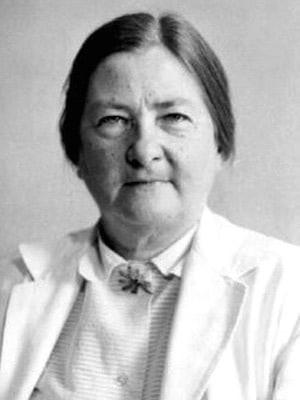Dorothy H. Andersen
Dorothy Hansine Andersen (1901-1963) was an American pediatrician and pathologist.
Andersen is known for first recognizing cystic fibrosis as a disease and creating a test to help diagnose it in 1938. Whilst performing an autopsy on a child with coeliac disease, she discovered a pancreatic lesion. After researching similar autopsy reports, she noted a pattern calling the process ‘cystic fibrosis of the pancreas.’ (1938). Andersen then led a team to develop a clinical diagnostic test for cystic fibrosis, which involved an assay of the pancreatic enzymes in the duodenal juice (1942).
Eponymously remembered for her description of Andersen disease (Glycogen storage disease type IV) in 1956
Biography
- Born on May 15, 1901 in Asheville, North Carolina
- 1922 – Bachelor of Arts in chemistry and zoology at Mount Holyoke College
- 1922-1926 MD, Johns Hopkins Medical School. Research work with Florence Rena Sabin (1871-1953) with first two publications on the lymphatic and vasculature in the reproductive organs of female pigs
- 1926-1927 Assistant in Anatomy at the University of Rochester,
- 1928 – Surgical intern at the Strong Memorial Hospital but denied residency on the basis of her gender.
- 1929 – Assistant in Pathology at the faculty of the College of Physicians and Surgeons of Columbia University
- 1935 – Professor of pathology at the the Babies Hospital at Colombia–Presbyterian Medical Center; Doctor of Medical Science, Columbia University.
- 1948 – awarded the Borden Award for research in Nutrition.
- 1952 – received the Elizabeth Blackwell Award for Women in Medicine.
- Died on March 3, 1963 in New York; heavy smoker died of lung cancer aged 61
Medical Eponyms
Andersen disease (1956) [Glycogen storage disease type IV]
Glycogen storage disease type IV is an autosomal recessive disorder due to deficient activity of the glycogen branching enzyme. The accumulation of glycogen in the liver leads to fibrosis and destruction of liver tissue. Symptoms usually present in the first years of life and include retarded growth and hepatosplenomegaly. Progression to liver failure means that without liver transplantation the disease is usually fatal by the age of five.
Cystic fibrosis
1938 – Cystic fibrosis – initial autopsy report and first use of the term ‘cystic fibrosis of the pancreas’. The key pathological features that were noted:
- Pancreatic acini replaced by epithelium lined cysts and surrounded by fibrous tissue.
- Evidence of bronchitis, bronchiectasis, pulmonary abscesses and lobar pneumonia was seen in the lungs. The most common bacteria found was Staph. aureus.
Vitamin A deficiency was evident in the majority of patients who died before the age of one. Atresia of the pancreatic duct, cystic duct or small intestine.
1942 – Assay of the pancreatic enzymes in the duodenal juice. The measurement of trypsin levels was found to be the most reliable enzyme assay in the diagnosis of pancreatic deficiency. Both lipase and amylase assays were found to be less reliable.
1951 – Report of Walter Kessler and Andersen in 1951 of heat prostration in children with cystic fibrosis during the New York heat wave in August 1948. 12 children (7 with CF) were admitted. First report that children with CF were particularly susceptible to heat. Led Paul di Sant’Agnese (working alongside Andersen) to further evaluate salt depletion in hot conditions.
1953 – First report of elevated sweat electrolytes in cystic fibrosis. Sweat from nine CF children and eight controls showed chloride more than three times higher in the people with CF than in the controls.
1959 – These discoveries by Anderson helped LE Gibson and RE Cooke develop the sweat test for cystic fibrosis diagnosis .
Major Publications
- Andersen DH. Lymphatics and blood vessels of the ovary of the sow. Contributions to Embryology. 1926; 17(88): 107-122
- Andersen DH. Cystic fibrosis of the pancreas and its relation to celiac disease. A clinical and pathological study. American Journal of Diseases of Children, 1938; 56: 344-399. [cystic fibrosis]
- Andersen DH. Pancreatic enzymes in the duodenal juice in the celiac syndrome. Am J Dis Child. 1942;63(4):643-658 [cystic fibrosis]
- Kessler WR, Andersen DH. Heat prostration in fibrocystic disease of the pancreas and other conditions. Pediatrics. 1951;8(5):648-656.
- Darling RC, di Sant’Agnese PA, Perera GA, Andersen DH. Electrolyte abnormalities of the sweat in fibrocystic disease of the pancreas. Am J Med Sci. 1953; 225(1): 67-70
- Andersen DH, Di Sant’Agnese PA. Idiopathic celiac disease. I. Mode of onset and diagnosis. Pediatrics. 1953;11(3):207-223.
- Andersen DH. Familial cirrhosis of the liver with storage of abnormal glycogen. Lab Invest. 1956;5(1):11-20. [Andersen disease]
References
Biography
- Damrosch DS. Dorothy Hansine Andersen. J Pediatr. 1964;65:477-479.
- Clague S. Dorothy Hansine Andersen. Lancet Respir Med. 2014;2(3):184-185.
- Aydelotte A. Andersen, Dorothy Hansine. American National Biography
- Bibliography. Andersen, Dorothy Hansine. WorldCat Identities
Eponymous terms
- Thomas E, Aziz-Donnelly A, Garcia-Santibanez R. Women in the History of Neuromuscular Medicine. Neuromuscular Disorders. 2019; 29: 698-703
- Gibson LE, Cooke RE. A test for concentration of electrolytes in sweat in cystic fibrosis of the pancreas utilizing pilocarpine by iontophoresis. Pediatrics. 1959;23:545–99.
- Marsden, Deborah. “Andersen Disease (GSD IV)”. NORD (National Organization of Rare Diseases).
[cite]
Studied at University of Leeds-MBChB and Microbiology in Relation to Medicine BSc. British doctor currently working in Emergency Medicine in Perth, Australia.


